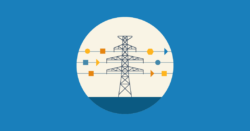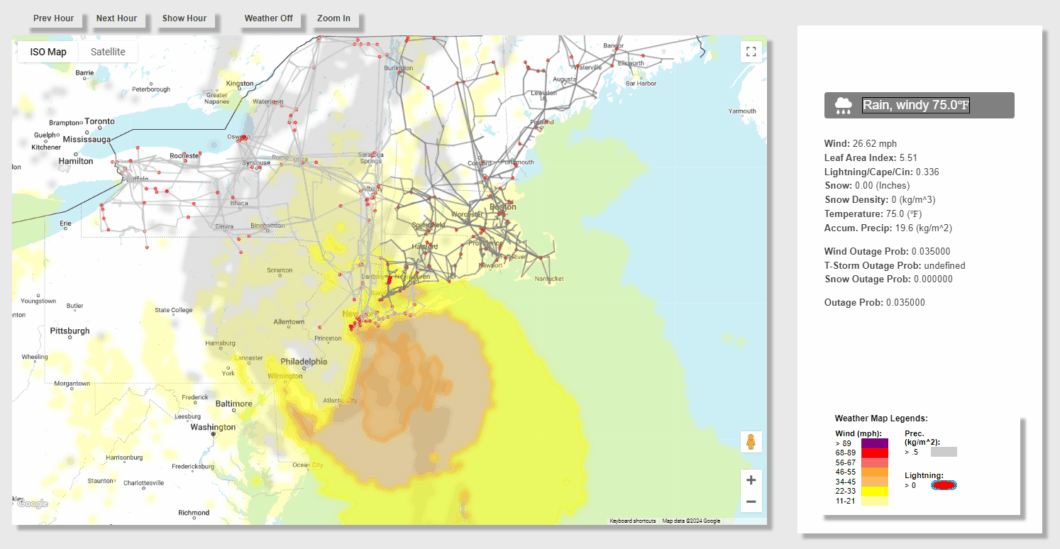Artificial intelligence helps predict transmission outages during storms

How can artificial intelligence enhance the reliability of the bulk electric system?
That’s a question ISO New England is exploring with the continuing development of a tool to identify the likelihood of weather-related equipment failures on the region’s high-voltage transmission network.
Roughly 9,000 miles’ worth of transmission lines crisscross New England. During any given storm, isolated segments of that network might go out of service until line crews make repairs. In most cases, there will be no interruption in the flow of power to consumers because of redundancies built into the transmission system.
While the ISO does not own or maintain any transmission, generation, or other energy infrastructure, its system operators work around the clock to ensure that supply and demand on the power system remain in balance.
Software called the Online Weather Lookahead Study (OWLS) aims to add another layer of reliability.
ISO New England began developing OWLS in 2019. From 2021 to 2023, the ISO collaborated with the Eversource Energy Center at the University of Connecticut to enhance the application with machine learning techniques. Machine learning is a subset of artificial intelligence that enables a system to learn and improve from experience. The center previously developed a similar approach for predicting outages on Eversource’s electric distribution system.

Mingguo Hong, principal research and development engineer with the ISO’s Advanced Technology Solutions group, integrated and refined the machine learning algorithms using regional transmission system data, and developed the OWLS user interface, which incorporates weather forecasts and a transmission system diagram into Google Maps.
OWLS is trained on massive amounts of data to identify weather-related threats to the transmission system up to 18 hours into the future. Its machine learning algorithms assign each transmission element an outage probability value.
For now, OWLS is strictly informational. Decisions about how to operate the transmission system remain with the ISO’s highly trained and experienced system operators, who adhere to procedures and standards set by the ISO and its regulators.
“OWLS cannot prophesy which line will go out,” Hong said. “There are a lot of factors that play into an outage. OWLS will bring them out and show you how much danger each transmission line is in.”
Different kinds of weather can lead to transmission outages. Heavy rain or snow can topple trees onto transmission lines. Strong winds or ice buildup can bring lines down as well. Lightning can strike transmission towers or substations and disrupt the normal flow of electricity.
To anticipate these kinds of problems, the OWLS machine learning algorithms are “trained” using information about New England’s transmission infrastructure, transmission outage logs, and high-resolution weather data from the National Oceanic and Atmospheric Administration.
The algorithms helped identify which weather parameters have the greatest impact on outages. For example, variables that appear to matter most for summer storms are average wind speed, maximum wind gust speed, and leaf area index. The last one is a measure of the density of leaves on trees, which can make a big difference because tree limbs weighed down by leaves are more likely to come down in a storm.

A significant portion of the OWLS training data derives from events like Tropical Storm Isaias in 2020. During Isaias, damage was concentrated in southwestern and central Connecticut, where wind gusts exceeded 60 mph.
New England experienced 32 transmission outages at the height of the storm, but none of them resulted in consumers losing power. The outages did, however, result in about 1,200 megawatts of generating capacity being cut off from the rest of the grid. (Storm damage to local electricity distribution systems, which the ISO does not control, resulted in 1.2 million customer outages.)
Isaias was not an extreme storm by historical standards, but it is an outlier among the 65 storms OWLS has been trained on. For now, the OWLS machine learning algorithms rely on weather data reaching back only as far as 2018. More data must be gathered going forward to prepare OWLS for more extreme weather that could cause widespread outages.
Xiaochuan Luo manages the Power System Technology group within the Advanced Technology Solutions department and oversees the OWLS project. He described Advanced Technology Solutions as the ISO’s internal research and development department. The team frequently collaborates with universities, national laboratories, and other external groups on projects that improve the efficiency and reliability of the New England power system.
In the future, Luo said, the machine learning principles developed for OWLS could be put to use in other areas of the ISO’s system operations and market administration functions.
- Categories
- Inside ISO New England
- Tags
- innovation, system operations, transmission
